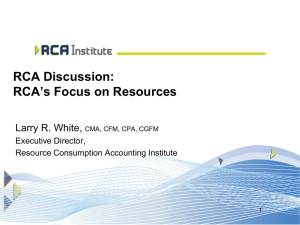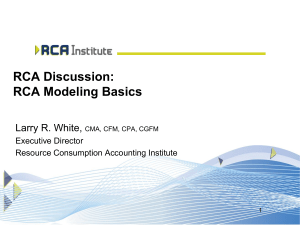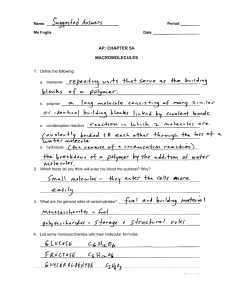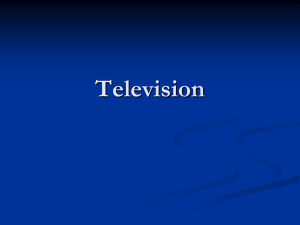Resource Consumption Accounting with Open Source Software
advertisement
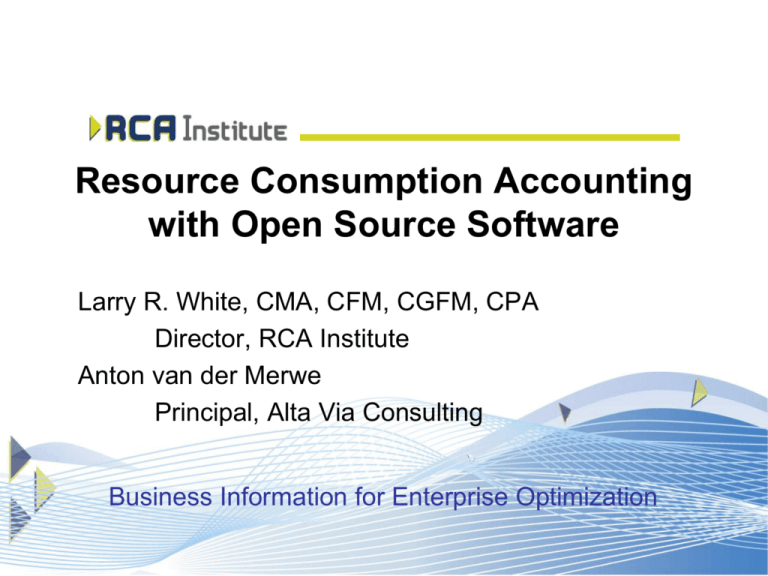
Resource Consumption Accounting with Open Source Software Larry R. White, CMA, CFM, CGFM, CPA Director, RCA Institute Anton van der Merwe Principal, Alta Via Consulting Business Information for Enterprise Optimization 1. RCA Introduction & RCA Modeling Principles 2. RCA Model Story Board and Business Situation 3. Overview of ROSA Software 4. Planning/Decision Scenarios 5. Overview of ROSA Manual 6. Implementing ROSA for Planning and Analysis 7. Questions Resource Consumption Accounting • RCA Inherits Core Principles from German Cost Management (GPK) Capacity Analysis and Management – Grenzplankostenrechnung (GPK) Translated Flexible Analytic Cost Planning & Control – Principles Applied in Practice since the late 1940’s – Implemented by 3,000+ Companies Process Analysis and Management RCA • RCA Integrates – Activity-based Costing and Throughput Concepts • RCA Creates an Integrated Economic Model of Operations for Decision Making – Enterprise Optimization – Principle Based – Highlights Resource Divisibility Resource view Advantages GPK CapacityFocused Process view Advantages ABC ActivityFocused 3 RCA Recognition Costing Continuum/Levels of Maturity Predictive: Demand Planning Driven with Capacity Sensitivity Descriptive: Expense Tracking, Cost Reporting and Consumption Rates Bookkeeping 1 Blind No marginal insights No Marginal Insight Process/ lean accounting 2 Process Visibility Limited process marginal insights Direct cost to outputs 3 Add indirect costs 4 Output Visibility Output Visibility Direct cost marginal insights All output cost marginal insights Individual std costs, project & job costing 5 Explicit Outputs Output specific marginal insights Push activitybased costing (ABC), Product costs 6 Explicit Indirect Costs Explicit output marginal insights Level 6 with customer & channel profitability reporting; Cost-toserve 7 Customer Demand Sensitive Add customer & channel marginal insights Marginal Insight Awareness Unused capacity costs (estimated) 8 (ABRP); forecast driver quantities X std unit rates, driverbased budgeting 9 Unused Capacity Aware Pull ABC Resource Planning Common fixed costs begin to be isolated Increased ability to isolate common fixed costs (TDABC); forecast driver quantities X std unit rates; direct cost focus; repetitive work conditions 10 Timedriven ABC Increased ability to isolate common fixed costs Attributable costs on all objects, blends activity and direct resource charges, consumes activities back to resources 11 R C A Explicit resource cost object, supplybased denominator, strong & weak forms of causality catered for Finite systems modeling 12 Simulation No change Detailed Marginal Insights What Causes Costs? Resources (also generates all revenues!) Every Decision is really a resource application decision! Proportional INPUT Fixed Services Support Resource Pool Proportional OUTPUT Fixed Organizational Element (Support or Production) Labor Equipment Operating Budget Another Resource Pool (s) Or Final Product/Service Products Services Support Work Requests (Reflecting Resources Applied) 6 What we need to know: Resource Pool A Resource Pool E Final Output 1 Final Output 2 Resource Pool B Resource Pool F Final Output 3 Resource Pool C Resource Pool G Resource Pool D Resource Pool H Final Output 4 RCA Storyboard S: Ancillary Production Equipment RP: Dryer (Hours) Capacity: 100 Output Qty: 100 S: Plant Engineering and Maintenance RP: Chiller (Hours) Capacity: 50,000 Output Qty: 50,000 RP: Plant Maintenance (Maint. Labor) Capacity: 30,000 Output Qty: 30,000 S: Administration Human Resources & Accounting Perfor m RP: Admin Labor (Labor hours) Capacity: 17,000 Output Qty: 17,000 HR Legend Perfor m S-Support Accou nting P- Production Perfor m P: Extrusion Line Department S: Quality Assurance Admin Resource Pool Abbreviated RP RP: Extrusion Labor (Labor hours) Capacity; 32,000 Output Qty: 30,000 RP: Extrusion Machine1 (Machine hours) Capacity; 17,520 Output Qty: 10,000 RP: QA Labor (Labor hours) Capacity: 14,000 Output Qty: 14,000 QA Testin g Activi ty Produ ct Manufacturing Costs Product Support Cost Retur ns Budgeted Products Product P & L’s Common Fixed Costs 8 RCA Information Plant Maintenance Resource Pool Output Measure: Maintenance Labor Hour Output Quantity: 20,000 Hours Primary Costs Fixed Proportional Technician Wages $ - $ 600,000 Supervisor Salary $ 80,000 $ General Material $ 12,000 $ Depreciation: Shop Equipment $ 50,000 $ $ 142,000 $ 700,000 $ 6,000 $ 24,000 $ $ 1,100 500 $ $ 10,000 $ 7,600 $ 34,000 $ 149,600 $ 734,000 100,000 - Secondary Costs Resource Pool Output Utilities MW-Hrs Activity/Process Driver HR: Benefits Adjustments Purchase: Gen Materials # Adjusts # PO's Fixed Qty Prop Qty 40 160 Fixed Qty Prop Qty 22 10 0 200 Total Resource Pool Costs Unit Cost Rates (/20,000 Hrs) 7.48 36.70 9 RCAStructure Structure RCA for Marginal Costing Quantitative Definition of Material Causal Relationships Support/Secondary Resource Pools Support/Secondary Activities Primary Resource Pools Primary Activities Product/Service Objects Result Segments Excess Capacity Costs RCA Provides Greatest Benefit • • • • High Capital Investment (Fixed Cost) Tight Margins Multiple Products/Services Flexible Production/Service Capability 1. RCA Introduction & RCA Modeling Principles 2. Example Story Board & Business Situation 3. Overview of ROSA Software 4. Planning/Decision Scenarios 5. Overview of ROSA Manual 6. Implementing ROSA for Planning and Analysis 7. Questions Get Well Corporation Get Well Mfg, Model Storyboard Support Costs Resource Pool: 6001 Utilities Electricity (Kwh) Cap = 250 000 Outp = 233 000 Resource Pool: 6201 System Support Infrastructure (Hr) Cap = 3000 Outp = 1750 Resource Pool: 6102 Facilities Square Feet (Sqft) Cap = 100 000 Outp = 87 000 Resource Pool: 6401 Maintenance Labor Hours (LH) Cap = 12 000 Outp = 11 280 Business Process 10020 Procure Raw Materials Outp = 40ea Business Process 10010 Service Machines Outp = 24ea Distribution Costs Production Costs Resource Pool: 6301 Distribution Tonmiles (Tm) Cap = 150 000 Outp = 150 000 Resource Pool: 9001 Packaging Labor hours (LH) Cap = 25 000 Outp = 23 340 Resource Pool: 9002 Packaging Machine Hours (MH) Cap = 4000 Outp = 3190 Resource Pool: 7002 Production 1 Machine Hours (MH) Cap = 2 200 Outp = 2 160 Resource Pool: 7001 Production 1 Labor Hours (LH) Cap = 15 000 Outp = 14 050 Product Costing PRODUCT 1: PRODUCT 2: PRODUCT 3: PRODUCT 4: NO PANE RELIEF BURN-AWAY BETTER-BEAT Resource Pool: 8001 Production 2 Labor Hours (LH) Cap = 6 500 Outp = 5890 Resource Pool: 8002 Production 2 Machine hours (MH) Cap = 2 000 Outp = 1 675 Get Well Support Resources Support Costs Resource Pool:6101Utilities Electricity (Kwh) Cap = 250 000 Outp = 233 000 Resource Pool:6102Facilities Square Feet (Sqft) Cap = 100 000 Outp = 87 000 Resource Pool:6201System Support Infrastructure (Hr) Cap = 3000 Outp = 1750 Business Process:10020 Procure Raw Materials Outp = 40ea Resource Pool:6401Maintenance Labor Hours (LH) Cap = 12 000 Outp = 11 280 Business Process:10010 Service Machines Outp = 24ea Get Well Distribution Resources Inputs from assigned Support Cost Centers Distribution Costs Resource Pool:6301Distribution Tonmiles (Tm) Cap = 150 000 Outp = 150 000 Resource Pool:9001Packaging Labor hours (LH) Cap = 25 000 Outp = 23 340 Outputs to assigned Product Cost Objects Resource Pool:9002Packaging Machine Hours (MH) Cap = 4000 Outp = 3190 Get Well Production Resources Input from assigned Support Costs Production Costs Resource Pool:7001Production 1 Labor Hours (LH) Cap = 15 000 Outp = 14 050 Resource Pool:7002Production 1 Machine Hours (MH) Cap = 2 200 Outp = 2 160 Outputs to assigned Product Cost Objects Input from Business Process: Service Machines Resource Pool:8001 Production 2 Labour Hours (LH) Cap = 6 500 Outp = 5890 Resource Pool:8002Production 2 Machine hours (MH) Cap = 2 000 Outp = 1 675 Get Well Products – Inputs from assigned Distribution and Production Costs Product Costing Input from Business Process: Procure Raw Materials PRODUCT 1: PRODUCT 2: PRODUCT 3: PRODUCT 4: NO PANE RELIEF BURN-AWAY BETTER-BEAT Outputs are categorized into different reporting segments as desired (ex., By customer, region, etc.) 1. RCA Introduction & RCA Modeling Principles 2. RCA Model Story Board and Business Situation 3. Overview of ROSA Software 4. Planning/Decision Scenarios 5. Overview of ROSA Manual 6. Implementing ROSA for Planning and Analysis 7. Questions ROSA Overview • Excel Template for PALO Business Intelligence Software – Template Designed by Alta Via Consulting – PALO BI Software S/W fm Jedox.com (Free & Open Source) • ROSA is a planning tool using RCA. – Template is not integrated with other systems to collect actual/results data. ROSA Overview Demo • Shift to displaying ROSA Application 1. RCA Introduction & RCA Modeling Principles 2. RCA Model Story Board and Business Situation 3. Overview of ROSA Software 4. Planning/Decision Scenarios 5. Overview of ROSA Manual 6. Implementing ROSA for Planning and Analysis 7. Questions Cost/Consumption Concepts Operational Decision Support Opportunity Cost Fixed Variable Avoidable Unavoidable “Relevant Range” Which Cost Concept Must Form the Basis for Cost Modeling? Can be Modeled Basis for Action Divisibility of Resource Information Example 1 A manufacturing company decides to replace an old extrusion plant with modern equipment. This results in a significant reduction in the amount of maintenance required. The maintenance manager realizes that he can reduce his total maintenance capacity by 8,000 hours, the equivalent of a whole crew including the crew's supervisor. What are the respective operational and decision cost concepts for each of technician wages and supervisor salary in Example 1? Example 1 Cont’d Operational Cost Concepts: The operational cost characteristics of technician wages is a variable cost The operational cost characteristics of supervisor salary is a fixed cost Decision Cost Concepts: Both technician wages and supervisor salary are avoidable cost Hence, operationally fixed and variable cost are avoidable Example 2 The same company receives an offer from an outside vendor to take over the repair of extrusion rollers. The manager knows from his MA system that the company spends 2,400 hours per year on these activities. A maintenance technician works 1,600 productive hours per year. What are the respective operational and decision cost concepts for each of technician wages and supervisor salary in Example 2? Example 2 Cont’d Operational Cost Concepts: The operational cost characteristics are the same as for Example 1 Decision Cost Concepts: The wages of one technician is an avoidable cost The costs associated with the remaining 800 hours (2,400 - 1,600) is unavoidable costs The crew supervisor will be less busy but his salary is similarly unavoidable Hence, operationally fixed and variable cost are now unavoidable cost Basis for All Cost Concepts Operational Cost Concepts Decision Cost Concepts Operations Cost Model with Causality as Its Basis Business Scenario 1 • Situation: Outsource the Maintenance Function? – A service provider approaches you with an offer to take over your maintenance function. – He proposes to charge you $29.00 per hour. As we will see from the ROSA model your cost is $30.84 per hour. – Should you accept the offer and outsource maintenance? • Shift to ROSA Application Business Scenario 2 • Situation: A Mutually Exclusive Resource Application Decision – You receive two orders but can only accept one due the customers’ required delivery dates. – Cost concept: The opportunity cost of committing a resource to a particular course of action. – Approximated by RCA’s proportional cost. • Shift to ROSA Application 1. RCA Introduction & RCA Modeling Principles 2. RCA Model Story Board and Business Situation 3. Overview of ROSA Software 4. Planning/Decision Scenarios 5. Overview of ROSA Manual 6. Implementing ROSA for Planning and Analysis 7. Questions ROSA Manual • ROSA Manual • Highlight: – Intro to RCA – Download and start up instructions – Application Overview – Building your own model en.wikibooks.org/wiki/RCA_Open_Source_Application:_ROSA_Manual 1. RCA Introduction & RCA Modeling Principles 2. RCA Model Story Board and Business Situation 3. Overview of ROSA Software 4. Planning/Decision Scenarios 5. Overview of ROSA Manual 6. Implementing ROSA for Planning and Analysis 7. Questions Using ROSA in Your Company • • • • • Conceptual RCA Model Design Design RCA Storyboard for your company Collect data and build initial data set Upload data to ROSA Use ROSA to simulate new business scenarios. ROSA Linked In Group http://www.linkedin.com/e/vgh/3107067/ The RCA Institute is… • A Non-profit Entity • Responsible for Training of Practitioners and Adopters • Provides A Number of Products and Services to Mitigate Adopter Risk e.g., Certification, Assurance Services • Sponsors Research into RCA Implementation and Longterm Use • Serves to Raise RCA Awareness and Fulfill Advocacy and Outreach Roles RCA Support & Quality Assurance • Institute Membership – Corporate & Individual • Certification – Specialist, Practitioner, Master – Software Products • Adopter Exploratory Workshops – Customized Workshops applying RCA to an organization • Implementation Review/Assurance – Support Adopting Organizations & Practitioner Expertise • Adopter Internal Use Reviews – Evaluations of An Organization’s Effectiveness Using and Maintaining RCA Questions??? ROSA Linked In Group: http://www.linkedin.com/e/vgh/3107067/ http://en.wikibooks.org/wiki/RCA_Open_Source_Application:_ROSA_Manual Contact Information: www.RCAInstitute.org lwhite@rcainstitute.org 757.288.6082 Contact Information: www.altavia.com antonvdm@altavia.com 513-257-7451
